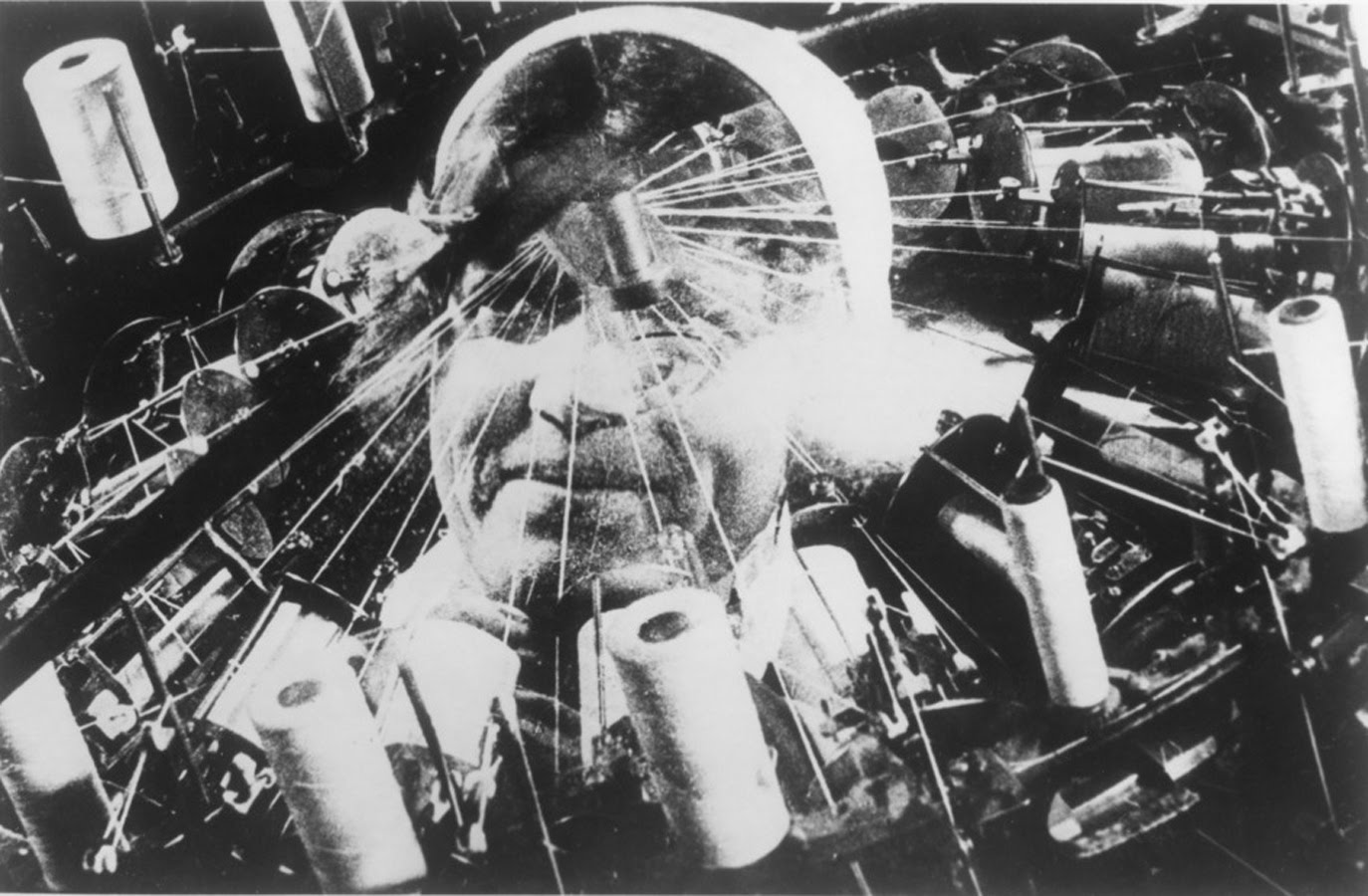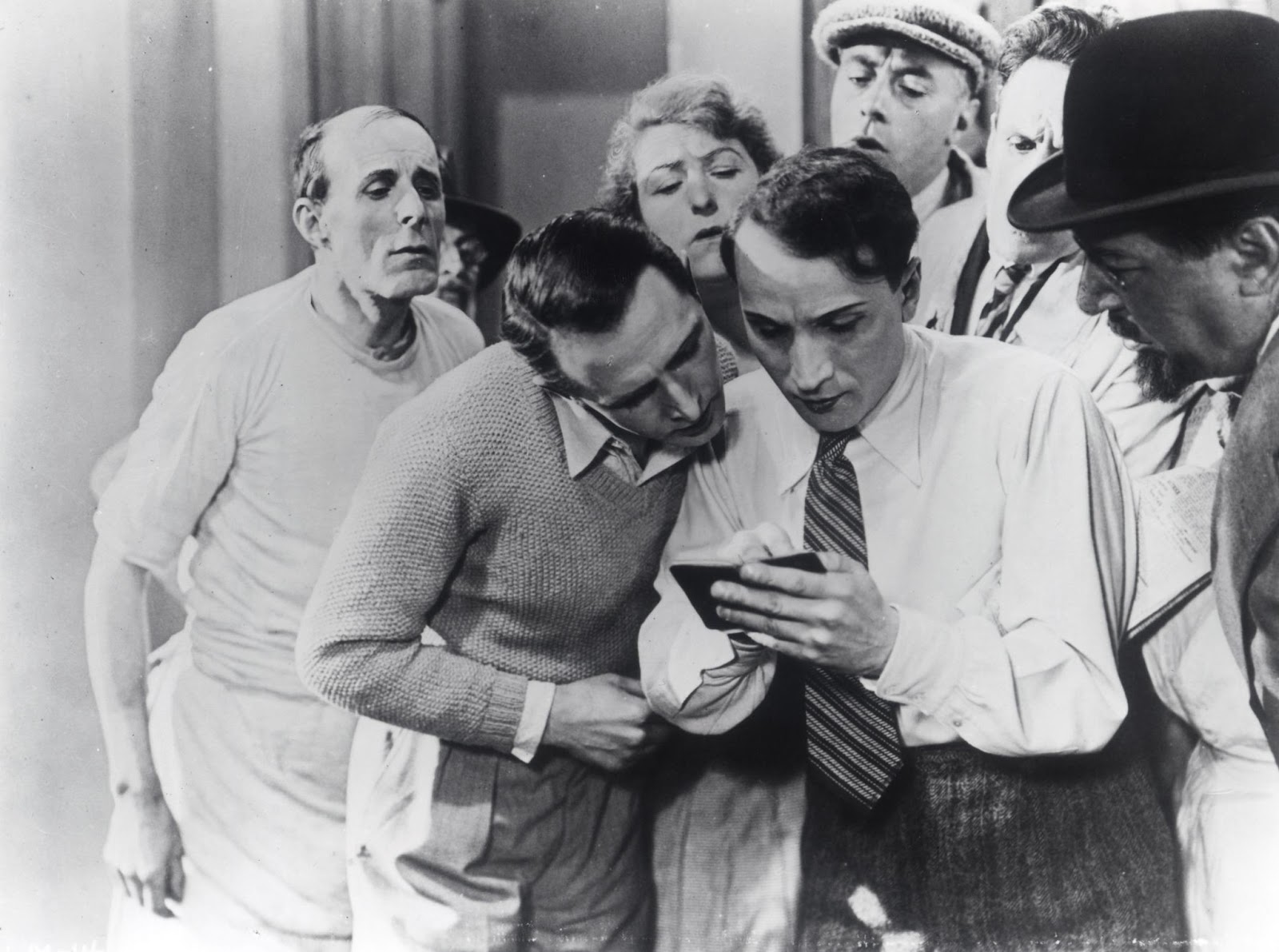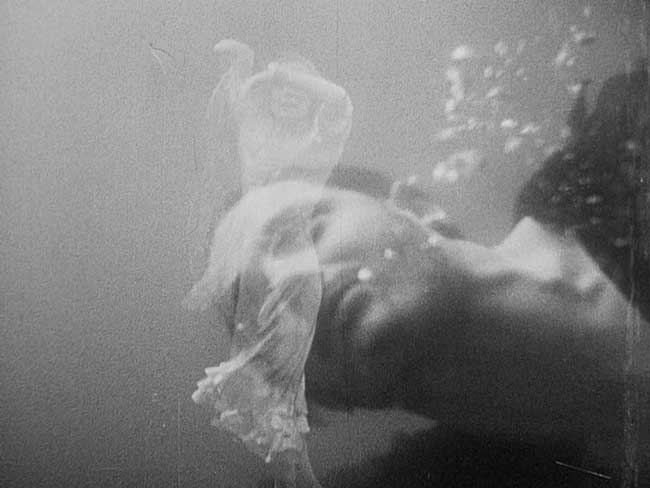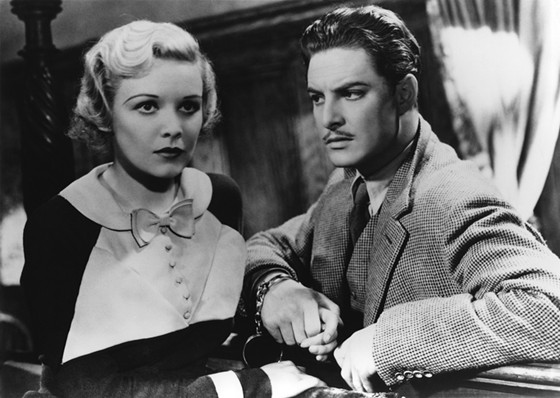13. The Man with the Movie Camera (1929)

Soviet cinema of the classic era is quite often better appreciated rather than loved. The best Soviet film makers were relentlessly inventive and experimental and film in that austere country seemed to exist either as a political thesis or as a way to explore the new medium. The crowning achievement in this last category is a film which, though acclaimed through the years, seemed to be something of an also ran until recently, when its reputation seemed to catch fire.
In 1927 the German documentarian Walter Ruttman scored a big hit with the subject film Berlin, Symphony of a Great City, which chronicled and celebrated a day in the life of the German capital. Not to be outdone, the Soviets commissioned a young editor turned documentarian to do the same thing for a day in the life of four major Russian cities, Moscow, Kiev, Karlakov and Odessa.
The young man involved bore the unlikely name of Dziga-Vertov (which means “spinning top” in Russian). He was actually Denis Kaufman and he came from a family greatly taken with the cinema. His brother Mikhail was also his cameraman (and later a noted documentarian himself) and his wife, Elizaveta Svilova, was also his editor. (Another brother was Boris Kaufman, later a distinguished Oscar winning cinematographer.)
With this solid familial support backing up his artistic aims (and not having to worry about anyone running to tattle to authorities),Dziga-Vertov let his imagination and ambitions run wild. What cinematic effect didn’t he create or refine for this film? It contains, slow motion, fast motion, double exposures, superimposition, odd angles, what would be later known as jump cuts, freeze frames and so much more.
It’s plain that he didn’t care deeply about life in the Soviet cities but, instead, about the possibilities of film. The result is perhaps the greatest of experimental films. Alas, as was the usual pattern of Soviet film history, the authorities looked on this triumph with great suspicion and declared it and Dziga Vertov suspect.
There followed the expected censorship and repression and, outside of the 1934 film Three Songs of Lenin (preserved in its preferred edit by Svilova), he saw his career diminish to end as editor of low profile films. However, in the latest poll of the illustrious Sight and Sound survey of greatest films of all time, The Man with a Movie Camera landed in eighth place.
14. Un chien Andalou/ L’age D’or (1929)

Spain had a most uneasy history during the Twentieth Century, notably a civil war which ended with a fascist regime ruling the country for much of the era. Though there would be some notable film makers such as Carlos Saura along the way, the two brightest lights of the country’s cinematic history were the two gleefully subversive film makers who bracketed the Franco days.
One is Pedro Almodovar in modern times and the other was the film world’s foremost surrealist, Luis Bunuel. Bunuel would come along just before the troublesome period started and he would pay dearly for his boldness, though time would be on his side. The cause of his personal travails was also what put him on the cinematic map and the results are well remembered to this day.
In his youth, Bunuel fell in with another artistic young man, painter Salvador Dali, who would become the best known surrealist in the art world. Both young men wanted to challenge the status quo of bourgeois society, ecclesiastical hypocrisy, sexual mores and all sorts of taboos.
To this end they first concocted a seventeen minute short, Un Chien Andalou (An Andalusian Dog). This affront to the stuffy and faint of heart started with a scene in which a woman’s eye is allegedly slit with a straight razor (Dali preoccupations) and proceeded from there to such sights as a young man in a nun’s habit and a severed hand with ants crawling over it (images seen over and over in Bunuel’s cinema).
A weird romance of sorts takes place between the woman and cross dressing young man but it’s all mixed with avant-garde vibes and Dadaist ideas. The short caused quite a stir but it was just a warm up to L’Age D’or (The Golden Age). In this one hour film (and what an hour!) another young couple try to get together, most definitely in a sexual manner, only to have society, the church, and all sorts of things get in their way.
It doesn’t help that the pair have a few…well, kinks (mud-covered sex, kissing the toes of statues in a sexual way). The swipes at the church did not make the Catholic Church, which was quite dominant in the Spain, happy. However, the final episode of the film, which jokingly linked Jesus Christ with the Marquis de Sade, was the last straw.
The church banned Bunuel from film making…for life! (Dali, who favored the Fascist, had distanced himself from Bunuel.) He had to flee not only the country but Europe. He landed in Mexico and worked in the publicity department of Warner Brothers Mexican office.
After more than a decade, he started making films in that country and managed to attract notice, quite rare for films from that country at the time. In the early 60s he got back to Europe and all the ideas he must have bottled up for those many years were unleashed. While most of the great film makers in the world go into an autumnal period, far from their greatest works, Bunuel seemed to only get better with age and he had a more triumphant last act than any other noted international director.
15. Earth (1930)

Add to the list of brilliant Russian shooting stars Alexander Dovzhenko, another film maker with great editing and visual style who all too soon ran afoul of the authorities.
Add to this the fact that Dovzhenko also had a quality that didn’t then (or later) often surface in Soviet cinema: he had a lyric passion, not just for the medium of film, but for his land and its people. He had come from what might well be called peasant stock in the Ukraine and labored to educate himself but it was service during World War I and the chance to start writing in that capacity which put him on a course to writing and then directing motion pictures.
When he did enter into that realm, he decided to concentrate on the grass roots provincial people of his origins. He hit pay dirt with his fourth film, Zvenigora in 1928. Next followed two films similar in tone and subject matter. 1929’s Arsenal was and is considered a fine example of Soviet cinema but for many 1930’s Earth was Dovzhenko’s magnum opus.
The ostensible subject matter is the phenomenon of “the kulaks”. This farming class sought to splinter away from the ruling Soviet system in order to create a collective movement which would be a commercial alternate to the then newly established government. To the surprise of no one, the group was declared an enemy sect and they did not survive for long. It was an act of courage to make a film about the group and truly brave to make that film a sympathetic one.
Past any political agenda, though, Dovzhenko displayed a love for the earth and agrarian life and those who dedicate their lives to the land. The imagery in this film is remarkable and quite passionate. How many films could include a scene of a farmer jubilantly dancing in the field over his joy concerning a new tractor without seeming ridiculous?
This film not only does this but makes this scene quite moving (though the episode’s punch line is anything but gentle or lyrical). Typically, the state didn’t care for the film and felt it counter-revolutionary. Dovzhenko’s career was thereafter in decline, though he scored a critical hit with 1939’s Shchors.
However, he did become a film teacher and mentor to such later figures as Larisa Shepitko. The cherry on the cake is that history has not only vindicated Dovzhenko but has placed Earth among the greatest of all films.
16. Le Million (1931)

The early sound era was, by all accounts, tumultuous indeed. The film industry the world over was scrambling to create a new dimension to match the by-now sophisticated visual one the film medium had achieved. Many of those who struck gold during this chaotic period oddly faded thereafter.
A perfect example is Hollywood director Rouben Mamoulian, who became expert but ordinary after the age of innovation was over. His perfect counterpart in Europe was French director Rene Clair. Clair was a comic film maker of unusual charm, both by the standards of that time and modern day. His films were full of love and laughter and comic frills and inventions and many over the years have compared his best works to lighter than air soufflés.
Though he had made something of a reputation in the silent days with some of his short films (The Crazy Ray and Entre’Act, both in 1924) and the still charming The Italian Straw Hat in 1928, he was just starting out in that era. However, when sound came along, Clair seized the opportunity and his sound debut was the lovingly Gallic amatory comedy Under the Roofs of Paris.
It was a big hit but even bigger was A Nous la Liberte (1931), a lovely farce which prefigured Chaplin’s 1936 Modern Times and, for many decades, one of the art house and text book staples.
However, Clair’s other 1931 film, Le Million, appears to weave its delicate spell over modern viewers to an even greater degree. Once more, this film is a romantic farce. A penniless young man (Rene Lefevre) owes everyone money and desperately wants to wed the girl of his dreams (a lovely and radiant Anabella) and his big chance comes when he discovers that the lottery ticket he has purchased is the winning number!
Too bad that the ticket was in the pocket of coat his best friend/roommate has given away! The ensuing film (which does not outstay its welcome) puts the man through various comic permutations in retrieving the ticket (and the film starts at the end and flashes back in a most beguiling way).
Clair, as ever, knew his comedy film making and he was so inventive with sound (a famous example is the overlay of the sounds of a football game during a raucous scene having nothing to do with sports). Added to this was the work of Clair’s frequent collaborators during that time, the gifted set designer Lazare Meerson and the noted cinematographer Georges Perinal, who create a wonderful Paris which never was or could have been but should have been.
Sad to say, the dark political forces bedeviling Europe in the 1930s drove Clair first to England then Hollywood in the mid-30s until after the war. He didn’t do at all badly but the white-hot period of his career was definitely over. He returned to France and had a few hits but he seemed a bit of a revered has-been even then. However, those who seek out his best films today will find pleasing charmers dated in the very best way.
17. L’Atalante (1934)

Every so often in cinema history there comes a great film which has a back story every bit as compelling as the film itself. A prime example of this select group is the remarkable French classic L’Atalante.
The story is a beautifully expressive and highly sensitive tale of a newlywed couple (Dita Parlo and Jean Daste) embarking on their new life aboard the husband’s rough barge, the title craft. The wife can’t relate to this harsh life and is also afraid initially of the bear-like deck hand, Jules (Michel Simon, one of the acting wonders of the world).
However, after trying to run away hysterically, she comes to appreciate the way her husband’s life style interacts with nature and her guide is Jules, a poet and saint of nature.
As with many great films, L’Atalante resists being described by mere words. The lovingly chosen and sensitively photographed images tell the story on a purely emotional level and the film must be seen and allowed to wash over the viewer for the full effect to register.
Off screen, the film was the only feature length effort of Jean Vigo, a fragile young man who appears to be the counterpart to Jules in real life. He had created two short films and a featurette, 1933’s amazing Zero for Conduct, still one of the most astounding and noted short subjects ever.
Vigo was born with health issues and time was always running out for him. His beloved gave birth to his daughter just as L’Atalante was premiering… all while Vigo lay dying. Sadly, he knew that the distributor wished to cut the film to make it more commercial. However, later generations restored it and today it remains a great monument to what might have been for Vigo.
18. The 39 Steps (1935)

Is there anyone with even a casual interest in film who doesn’t know the legendary “master of suspense”, Alfred Hitchcock? Hitchcock’s persona and film making style are still among the most recognizable in film history. However, everyone has beginnings and Hitchcock began as a set and title card designer in the British film industry during the silent days and scored a hit with his debut, 1927’s thriller classic The Lodger.
The rest of the silent period wasn’t as memorable, though he himself was famed as “the boy director”. Though he always exalted the silent cinema as the purest visual form, sound seemed to bring out the highest expression of his creativity (and it didn’t hurt that his and Britain’s first talkie, 1929’s Blackmail, was a big all around hit). However, for a handful of years just after sound came, he remained just outside of international fame.
Though he came close with 1934’s The Man Who Knew Too Much (which he remade lavishly in his Hollywood days), the film which brought Hitchcock into the international limelight was The 39 Steps. Technically, the film was an adaptation of the World War I era spy novel by John Buchan, a classic even then. However, Hitchcock and his team really took the basic ideas and rebuilt them into a new cinematic entity (a common occurrence throughout Hitchcock’s work).
The basic plot was one Hitchcock would return to again and again: an innocent man stumbles into a criminal/espionage plot, gets framed for a murder, and must go on the lamb, fleeing both criminals and the law, while romancing a lovely blonde (always a blonde) along the way.
To many, Hitchcock’s greatest film of this type was 1959’s North by Northwest. However, neither that film nor the other similar films Hitchcock created would have existed quite the same way without The 39 Steps, which is still fresh and lively.
The cast is headed by the excellent (later Oscar-winning) Robert Donat and the exquisite Madeline Carroll (the first true “Hitchcock blonde”) and includes fine turns by Godfrey Terle as the villain (and who, perversely, was the image of then-US president Franklin Roosevelt!), Lucie Mannheim and a young Peggy Ashcroft, long before she was a dame.
However, the true star of this and any other Hitchcock film was Hitchcock, a director who knew more about imagery, camera angles, and cutting than anyone and who served it all up with a wicked and sophisticated sense of humor.